Business Report: Exploring the Turkish Wine Industry's Potential
VerifiedAdded on 2019/09/30
|25
|4422
|258
Report
AI Summary
This report provides a comprehensive analysis of the Turkish wine industry, examining its current state, challenges, and opportunities for growth. It begins with an introduction to the industry, highlighting Turkey's position as a significant wine-producing country. The core of the report utilizes Porter's National Diamond framework to analyze factor conditions, demand conditions, related and supporting industries, firm strategy and rivalry, the role of government, and chance. The report then delves into Foreign Direct Investment (FDI), discussing its advantages and disadvantages as a mode of entry, and proposes a market entry strategy for the Turkish wine industry. Finally, it addresses key management issues such as corruption, high taxes, and the lack of skilled labor. The analysis provides insights into the industry's strengths and weaknesses, offering a strategic perspective on its future development and investment viability.
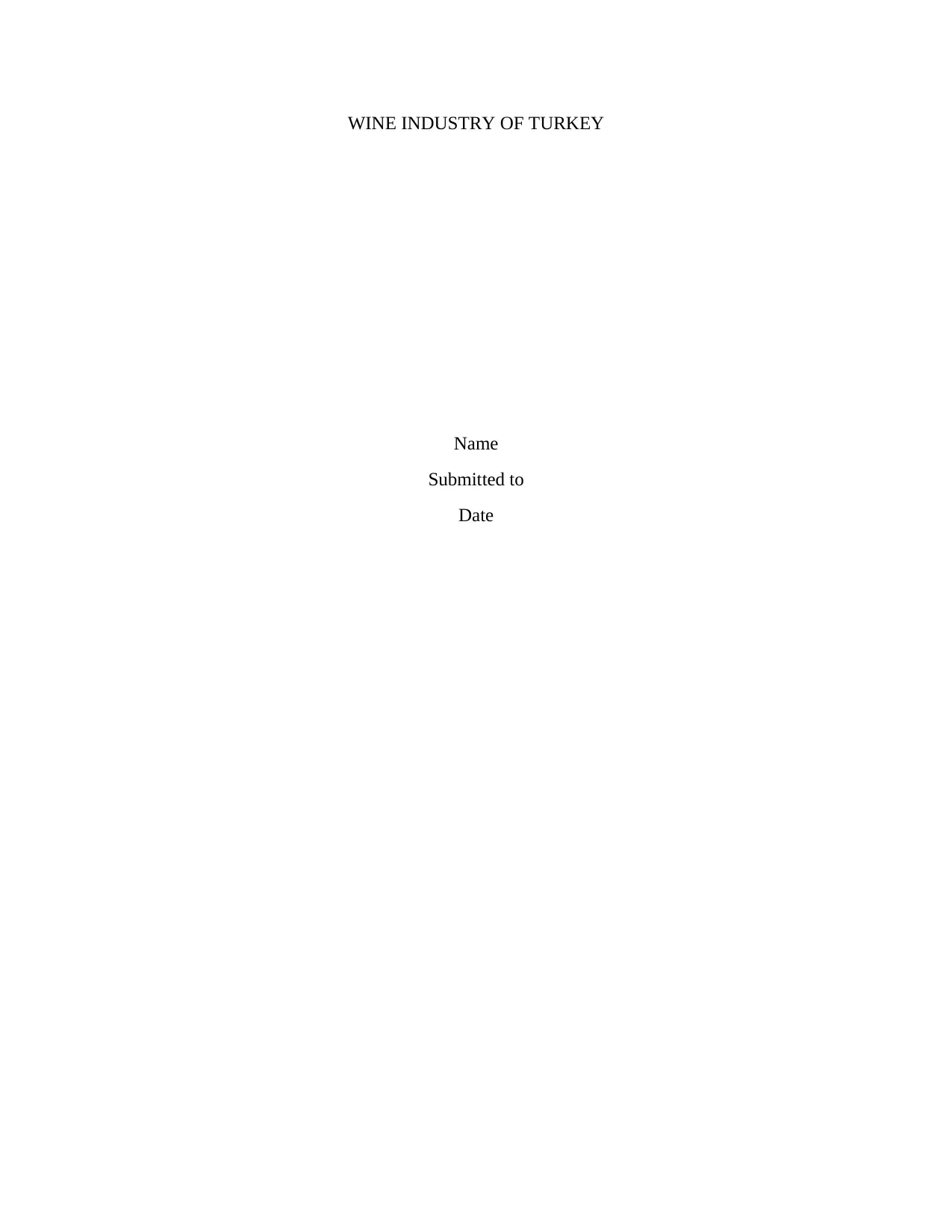
WINE INDUSTRY OF TURKEY
Name
Submitted to
Date
Name
Submitted to
Date
Paraphrase This Document
Need a fresh take? Get an instant paraphrase of this document with our AI Paraphraser
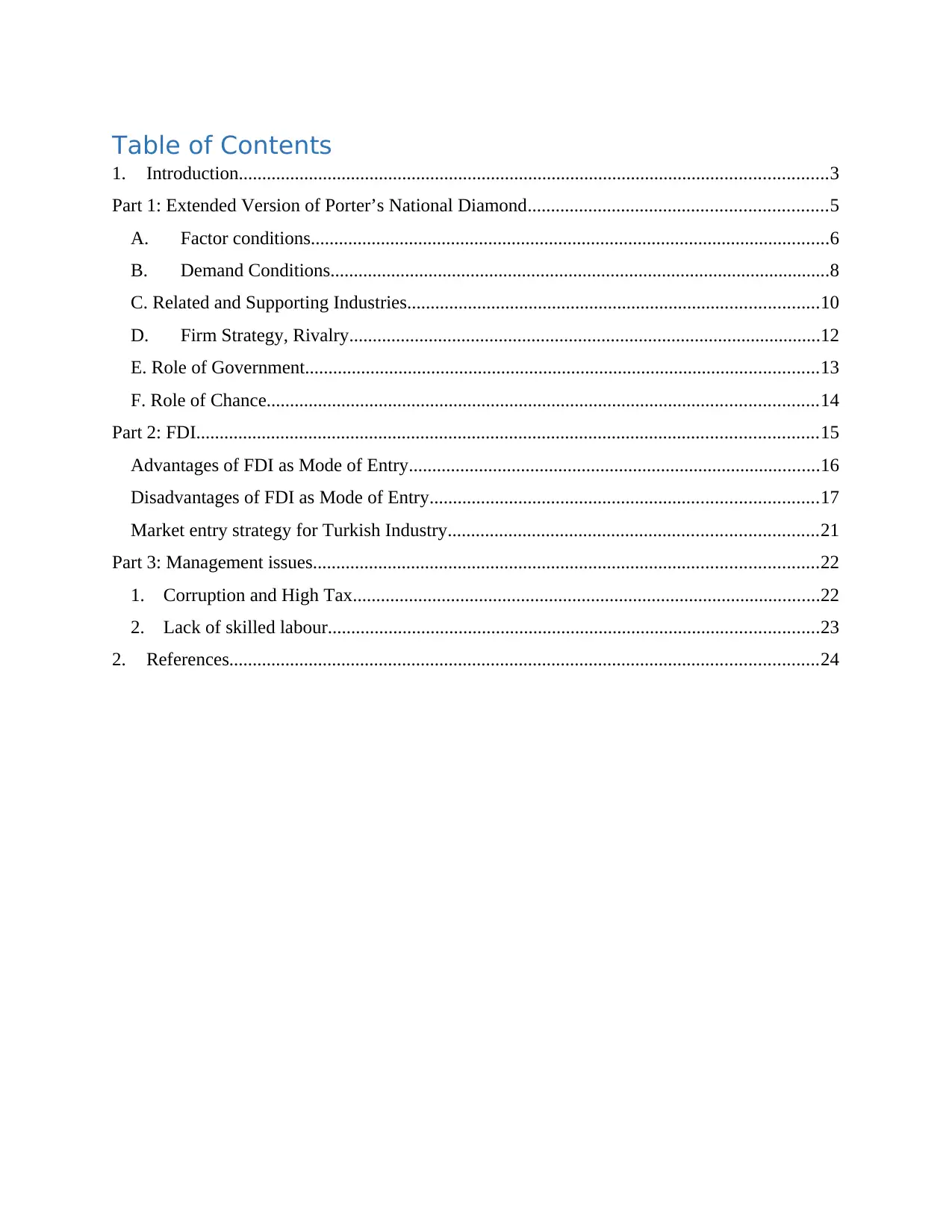
Table of Contents
1. Introduction..............................................................................................................................3
Part 1: Extended Version of Porter’s National Diamond................................................................5
A. Factor conditions...............................................................................................................6
B. Demand Conditions...........................................................................................................8
C. Related and Supporting Industries........................................................................................10
D. Firm Strategy, Rivalry.....................................................................................................12
E. Role of Government..............................................................................................................13
F. Role of Chance......................................................................................................................14
Part 2: FDI.....................................................................................................................................15
Advantages of FDI as Mode of Entry........................................................................................16
Disadvantages of FDI as Mode of Entry...................................................................................17
Market entry strategy for Turkish Industry...............................................................................21
Part 3: Management issues............................................................................................................22
1. Corruption and High Tax....................................................................................................22
2. Lack of skilled labour.........................................................................................................23
2. References..............................................................................................................................24
1. Introduction..............................................................................................................................3
Part 1: Extended Version of Porter’s National Diamond................................................................5
A. Factor conditions...............................................................................................................6
B. Demand Conditions...........................................................................................................8
C. Related and Supporting Industries........................................................................................10
D. Firm Strategy, Rivalry.....................................................................................................12
E. Role of Government..............................................................................................................13
F. Role of Chance......................................................................................................................14
Part 2: FDI.....................................................................................................................................15
Advantages of FDI as Mode of Entry........................................................................................16
Disadvantages of FDI as Mode of Entry...................................................................................17
Market entry strategy for Turkish Industry...............................................................................21
Part 3: Management issues............................................................................................................22
1. Corruption and High Tax....................................................................................................22
2. Lack of skilled labour.........................................................................................................23
2. References..............................................................................................................................24
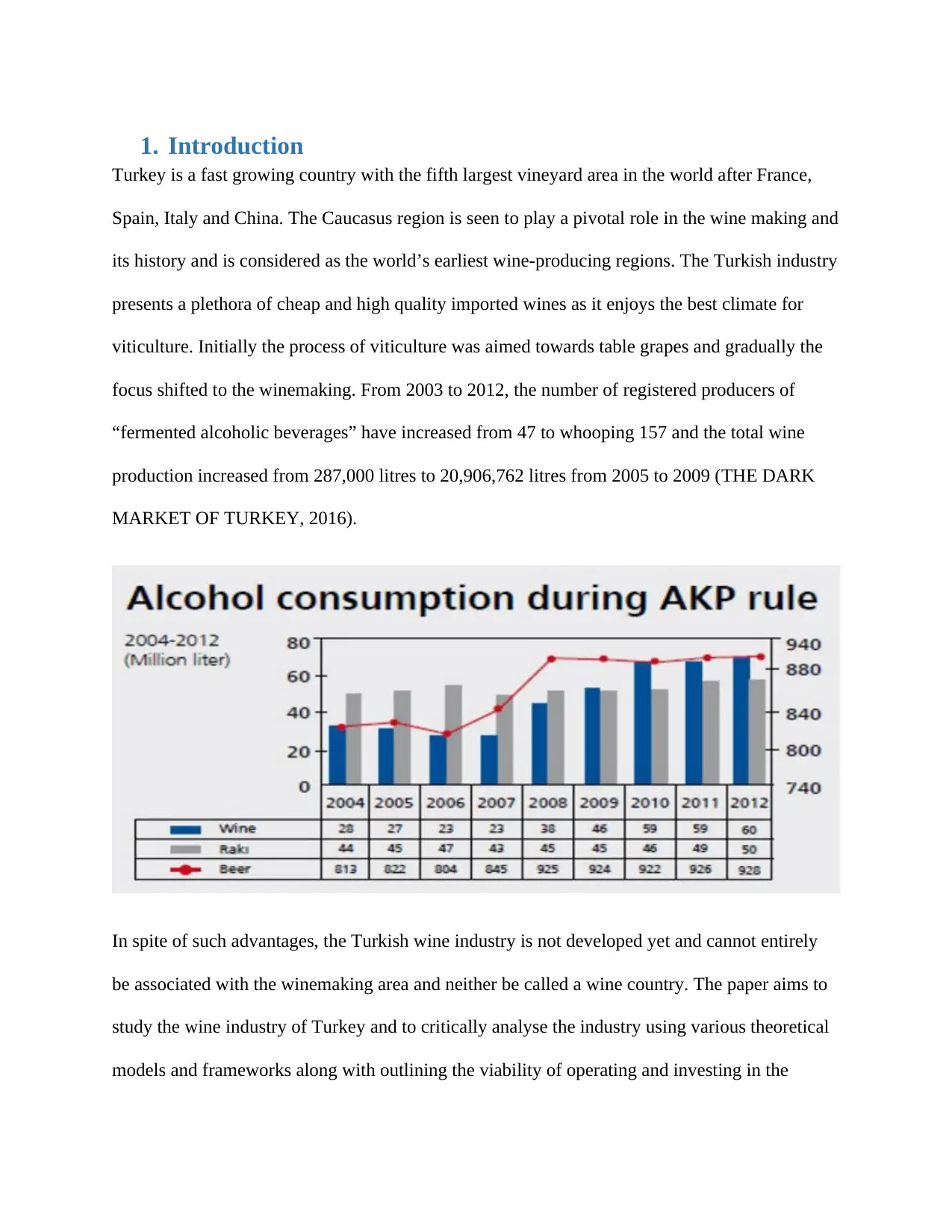
1. Introduction
Turkey is a fast growing country with the fifth largest vineyard area in the world after France,
Spain, Italy and China. The Caucasus region is seen to play a pivotal role in the wine making and
its history and is considered as the world’s earliest wine-producing regions. The Turkish industry
presents a plethora of cheap and high quality imported wines as it enjoys the best climate for
viticulture. Initially the process of viticulture was aimed towards table grapes and gradually the
focus shifted to the winemaking. From 2003 to 2012, the number of registered producers of
“fermented alcoholic beverages” have increased from 47 to whooping 157 and the total wine
production increased from 287,000 litres to 20,906,762 litres from 2005 to 2009 (THE DARK
MARKET OF TURKEY, 2016).
In spite of such advantages, the Turkish wine industry is not developed yet and cannot entirely
be associated with the winemaking area and neither be called a wine country. The paper aims to
study the wine industry of Turkey and to critically analyse the industry using various theoretical
models and frameworks along with outlining the viability of operating and investing in the
Turkey is a fast growing country with the fifth largest vineyard area in the world after France,
Spain, Italy and China. The Caucasus region is seen to play a pivotal role in the wine making and
its history and is considered as the world’s earliest wine-producing regions. The Turkish industry
presents a plethora of cheap and high quality imported wines as it enjoys the best climate for
viticulture. Initially the process of viticulture was aimed towards table grapes and gradually the
focus shifted to the winemaking. From 2003 to 2012, the number of registered producers of
“fermented alcoholic beverages” have increased from 47 to whooping 157 and the total wine
production increased from 287,000 litres to 20,906,762 litres from 2005 to 2009 (THE DARK
MARKET OF TURKEY, 2016).
In spite of such advantages, the Turkish wine industry is not developed yet and cannot entirely
be associated with the winemaking area and neither be called a wine country. The paper aims to
study the wine industry of Turkey and to critically analyse the industry using various theoretical
models and frameworks along with outlining the viability of operating and investing in the
⊘ This is a preview!⊘
Do you want full access?
Subscribe today to unlock all pages.

Trusted by 1+ million students worldwide
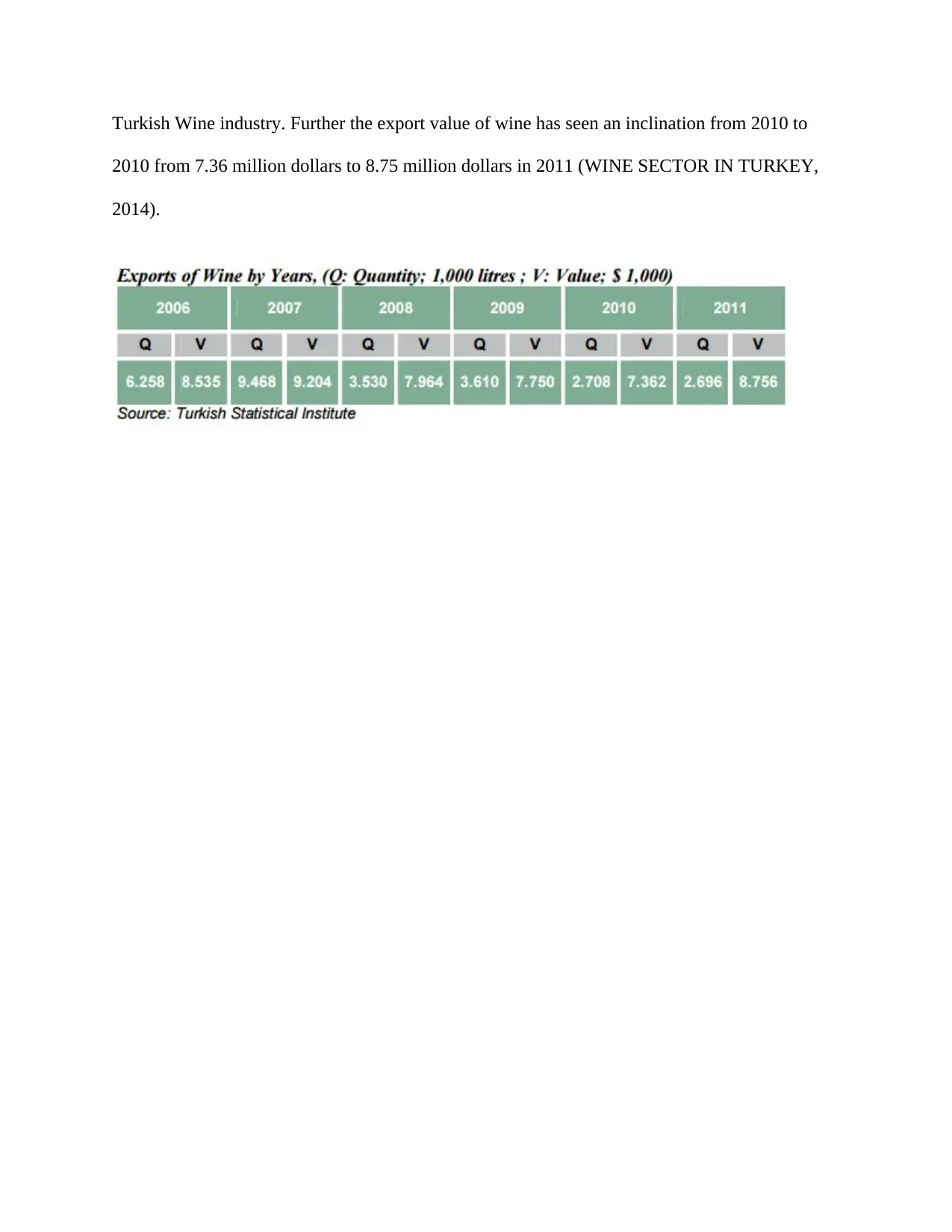
Turkish Wine industry. Further the export value of wine has seen an inclination from 2010 to
2010 from 7.36 million dollars to 8.75 million dollars in 2011 (WINE SECTOR IN TURKEY,
2014).
2010 from 7.36 million dollars to 8.75 million dollars in 2011 (WINE SECTOR IN TURKEY,
2014).
Paraphrase This Document
Need a fresh take? Get an instant paraphrase of this document with our AI Paraphraser
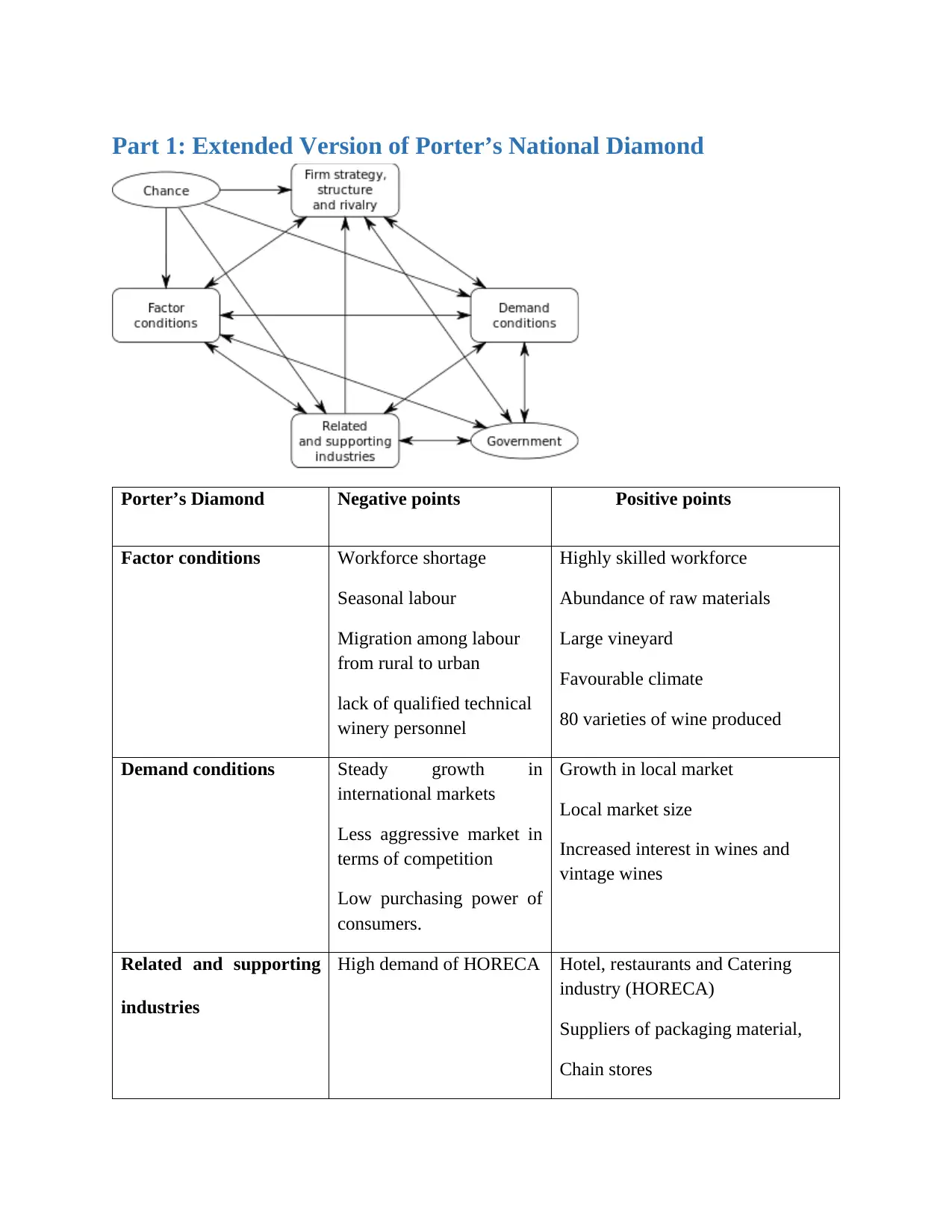
Part 1: Extended Version of Porter’s National Diamond
Porter’s Diamond Negative points Positive points
Factor conditions Workforce shortage
Seasonal labour
Migration among labour
from rural to urban
lack of qualified technical
winery personnel
Highly skilled workforce
Abundance of raw materials
Large vineyard
Favourable climate
80 varieties of wine produced
Demand conditions Steady growth in
international markets
Less aggressive market in
terms of competition
Low purchasing power of
consumers.
Growth in local market
Local market size
Increased interest in wines and
vintage wines
Related and supporting
industries
High demand of HORECA Hotel, restaurants and Catering
industry (HORECA)
Suppliers of packaging material,
Chain stores
Porter’s Diamond Negative points Positive points
Factor conditions Workforce shortage
Seasonal labour
Migration among labour
from rural to urban
lack of qualified technical
winery personnel
Highly skilled workforce
Abundance of raw materials
Large vineyard
Favourable climate
80 varieties of wine produced
Demand conditions Steady growth in
international markets
Less aggressive market in
terms of competition
Low purchasing power of
consumers.
Growth in local market
Local market size
Increased interest in wines and
vintage wines
Related and supporting
industries
High demand of HORECA Hotel, restaurants and Catering
industry (HORECA)
Suppliers of packaging material,
Chain stores
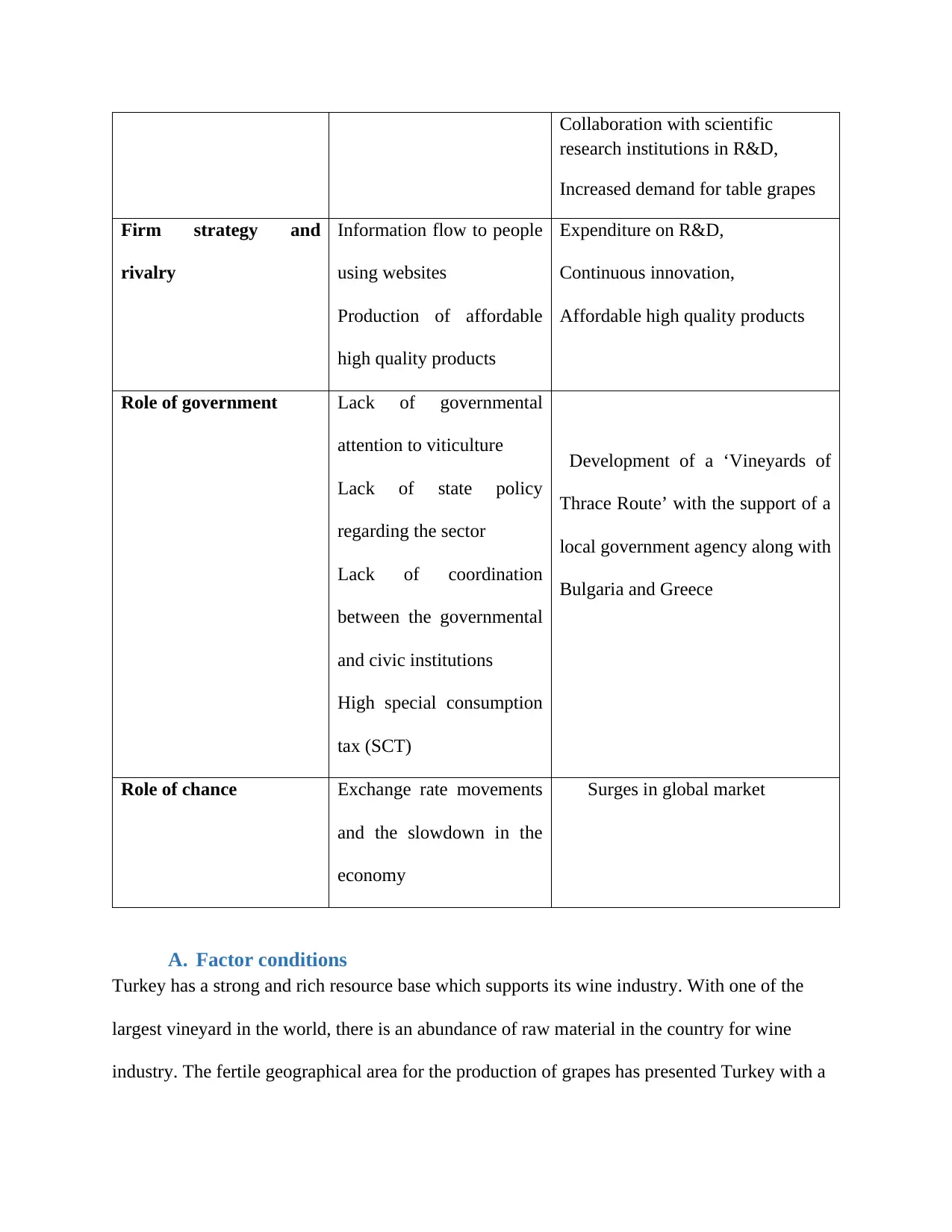
Collaboration with scientific
research institutions in R&D,
Increased demand for table grapes
Firm strategy and
rivalry
Information flow to people
using websites
Production of affordable
high quality products
Expenditure on R&D,
Continuous innovation,
Affordable high quality products
Role of government Lack of governmental
attention to viticulture
Lack of state policy
regarding the sector
Lack of coordination
between the governmental
and civic institutions
High special consumption
tax (SCT)
Development of a ‘Vineyards of
Thrace Route’ with the support of a
local government agency along with
Bulgaria and Greece
Role of chance Exchange rate movements
and the slowdown in the
economy
Surges in global market
A. Factor conditions
Turkey has a strong and rich resource base which supports its wine industry. With one of the
largest vineyard in the world, there is an abundance of raw material in the country for wine
industry. The fertile geographical area for the production of grapes has presented Turkey with a
research institutions in R&D,
Increased demand for table grapes
Firm strategy and
rivalry
Information flow to people
using websites
Production of affordable
high quality products
Expenditure on R&D,
Continuous innovation,
Affordable high quality products
Role of government Lack of governmental
attention to viticulture
Lack of state policy
regarding the sector
Lack of coordination
between the governmental
and civic institutions
High special consumption
tax (SCT)
Development of a ‘Vineyards of
Thrace Route’ with the support of a
local government agency along with
Bulgaria and Greece
Role of chance Exchange rate movements
and the slowdown in the
economy
Surges in global market
A. Factor conditions
Turkey has a strong and rich resource base which supports its wine industry. With one of the
largest vineyard in the world, there is an abundance of raw material in the country for wine
industry. The fertile geographical area for the production of grapes has presented Turkey with a
⊘ This is a preview!⊘
Do you want full access?
Subscribe today to unlock all pages.

Trusted by 1+ million students worldwide

rooted vinery culture. There are around 1100 types of grape being produced in Turkey with only
selected 34 varieties being used for wine production (Azabagaoglu, M.O., Akyol, A. and Ozay,
A., 2006).
Due to large abundance of raw materials and favourable climate, the 1/3 of the entire grape
production is used for preparation of wine. The table given below presents the overall area under
vines from 2000 to 2013 along with depicting the decrease or increase in area (THE DARK
MARKET OF TURKEY, 2016)
Furthermore, the workforce is highly skilled and are effective in handling the whole wine
making process. They can be considered as an asset to the whole wine making industry of
Turkey. However, the industry is seen to face storage of workforce due to internal migration of
the rural people to the urban areas in last few decades. This decreased the number of workforce
working in the vineyards. Adding to that, various wineries have seasonal labour who are situated
in rural areas where there is a lack of specialist workforce. Due to presence of seasonal labour,
there is high probability of uncertainty in the work process. Interestingly, the country lacks the
presence of qualified technical winery personnel to keep a check on the quality of the product
from time to time. There were over 80 wineries (in 2004) in the country accounting for the total
selected 34 varieties being used for wine production (Azabagaoglu, M.O., Akyol, A. and Ozay,
A., 2006).
Due to large abundance of raw materials and favourable climate, the 1/3 of the entire grape
production is used for preparation of wine. The table given below presents the overall area under
vines from 2000 to 2013 along with depicting the decrease or increase in area (THE DARK
MARKET OF TURKEY, 2016)
Furthermore, the workforce is highly skilled and are effective in handling the whole wine
making process. They can be considered as an asset to the whole wine making industry of
Turkey. However, the industry is seen to face storage of workforce due to internal migration of
the rural people to the urban areas in last few decades. This decreased the number of workforce
working in the vineyards. Adding to that, various wineries have seasonal labour who are situated
in rural areas where there is a lack of specialist workforce. Due to presence of seasonal labour,
there is high probability of uncertainty in the work process. Interestingly, the country lacks the
presence of qualified technical winery personnel to keep a check on the quality of the product
from time to time. There were over 80 wineries (in 2004) in the country accounting for the total
Paraphrase This Document
Need a fresh take? Get an instant paraphrase of this document with our AI Paraphraser
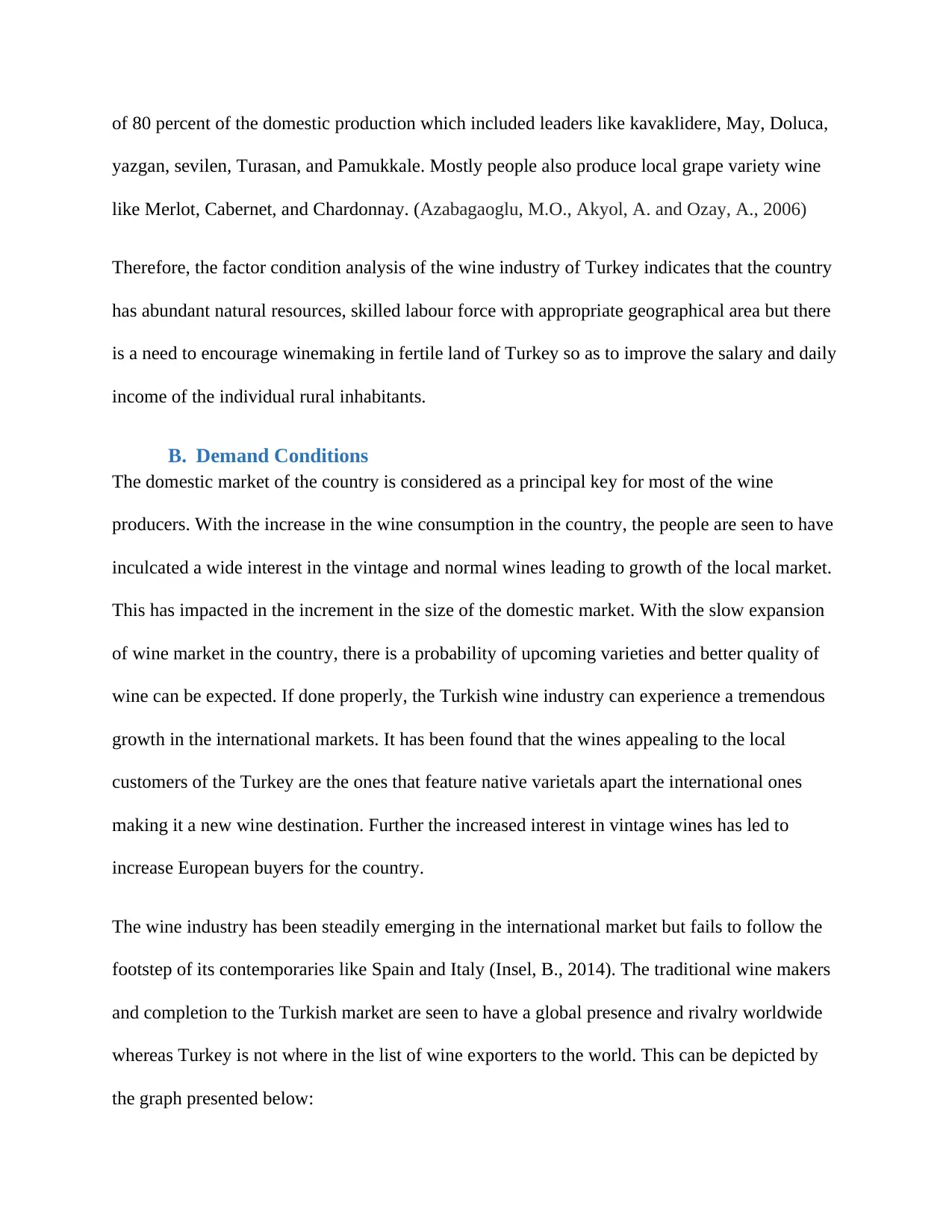
of 80 percent of the domestic production which included leaders like kavaklidere, May, Doluca,
yazgan, sevilen, Turasan, and Pamukkale. Mostly people also produce local grape variety wine
like Merlot, Cabernet, and Chardonnay. (Azabagaoglu, M.O., Akyol, A. and Ozay, A., 2006)
Therefore, the factor condition analysis of the wine industry of Turkey indicates that the country
has abundant natural resources, skilled labour force with appropriate geographical area but there
is a need to encourage winemaking in fertile land of Turkey so as to improve the salary and daily
income of the individual rural inhabitants.
B. Demand Conditions
The domestic market of the country is considered as a principal key for most of the wine
producers. With the increase in the wine consumption in the country, the people are seen to have
inculcated a wide interest in the vintage and normal wines leading to growth of the local market.
This has impacted in the increment in the size of the domestic market. With the slow expansion
of wine market in the country, there is a probability of upcoming varieties and better quality of
wine can be expected. If done properly, the Turkish wine industry can experience a tremendous
growth in the international markets. It has been found that the wines appealing to the local
customers of the Turkey are the ones that feature native varietals apart the international ones
making it a new wine destination. Further the increased interest in vintage wines has led to
increase European buyers for the country.
The wine industry has been steadily emerging in the international market but fails to follow the
footstep of its contemporaries like Spain and Italy (Insel, B., 2014). The traditional wine makers
and completion to the Turkish market are seen to have a global presence and rivalry worldwide
whereas Turkey is not where in the list of wine exporters to the world. This can be depicted by
the graph presented below:
yazgan, sevilen, Turasan, and Pamukkale. Mostly people also produce local grape variety wine
like Merlot, Cabernet, and Chardonnay. (Azabagaoglu, M.O., Akyol, A. and Ozay, A., 2006)
Therefore, the factor condition analysis of the wine industry of Turkey indicates that the country
has abundant natural resources, skilled labour force with appropriate geographical area but there
is a need to encourage winemaking in fertile land of Turkey so as to improve the salary and daily
income of the individual rural inhabitants.
B. Demand Conditions
The domestic market of the country is considered as a principal key for most of the wine
producers. With the increase in the wine consumption in the country, the people are seen to have
inculcated a wide interest in the vintage and normal wines leading to growth of the local market.
This has impacted in the increment in the size of the domestic market. With the slow expansion
of wine market in the country, there is a probability of upcoming varieties and better quality of
wine can be expected. If done properly, the Turkish wine industry can experience a tremendous
growth in the international markets. It has been found that the wines appealing to the local
customers of the Turkey are the ones that feature native varietals apart the international ones
making it a new wine destination. Further the increased interest in vintage wines has led to
increase European buyers for the country.
The wine industry has been steadily emerging in the international market but fails to follow the
footstep of its contemporaries like Spain and Italy (Insel, B., 2014). The traditional wine makers
and completion to the Turkish market are seen to have a global presence and rivalry worldwide
whereas Turkey is not where in the list of wine exporters to the world. This can be depicted by
the graph presented below:
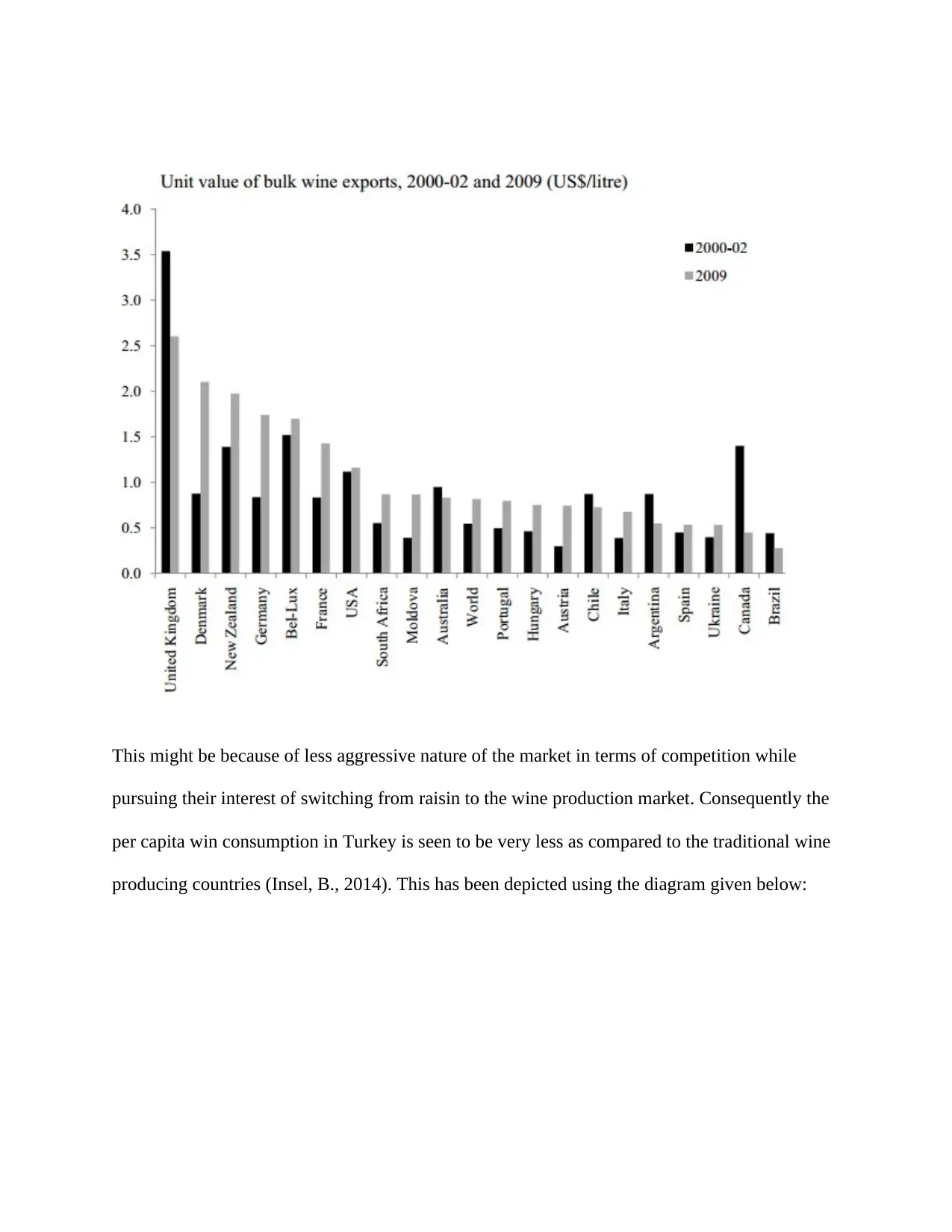
This might be because of less aggressive nature of the market in terms of competition while
pursuing their interest of switching from raisin to the wine production market. Consequently the
per capita win consumption in Turkey is seen to be very less as compared to the traditional wine
producing countries (Insel, B., 2014). This has been depicted using the diagram given below:
pursuing their interest of switching from raisin to the wine production market. Consequently the
per capita win consumption in Turkey is seen to be very less as compared to the traditional wine
producing countries (Insel, B., 2014). This has been depicted using the diagram given below:
⊘ This is a preview!⊘
Do you want full access?
Subscribe today to unlock all pages.

Trusted by 1+ million students worldwide
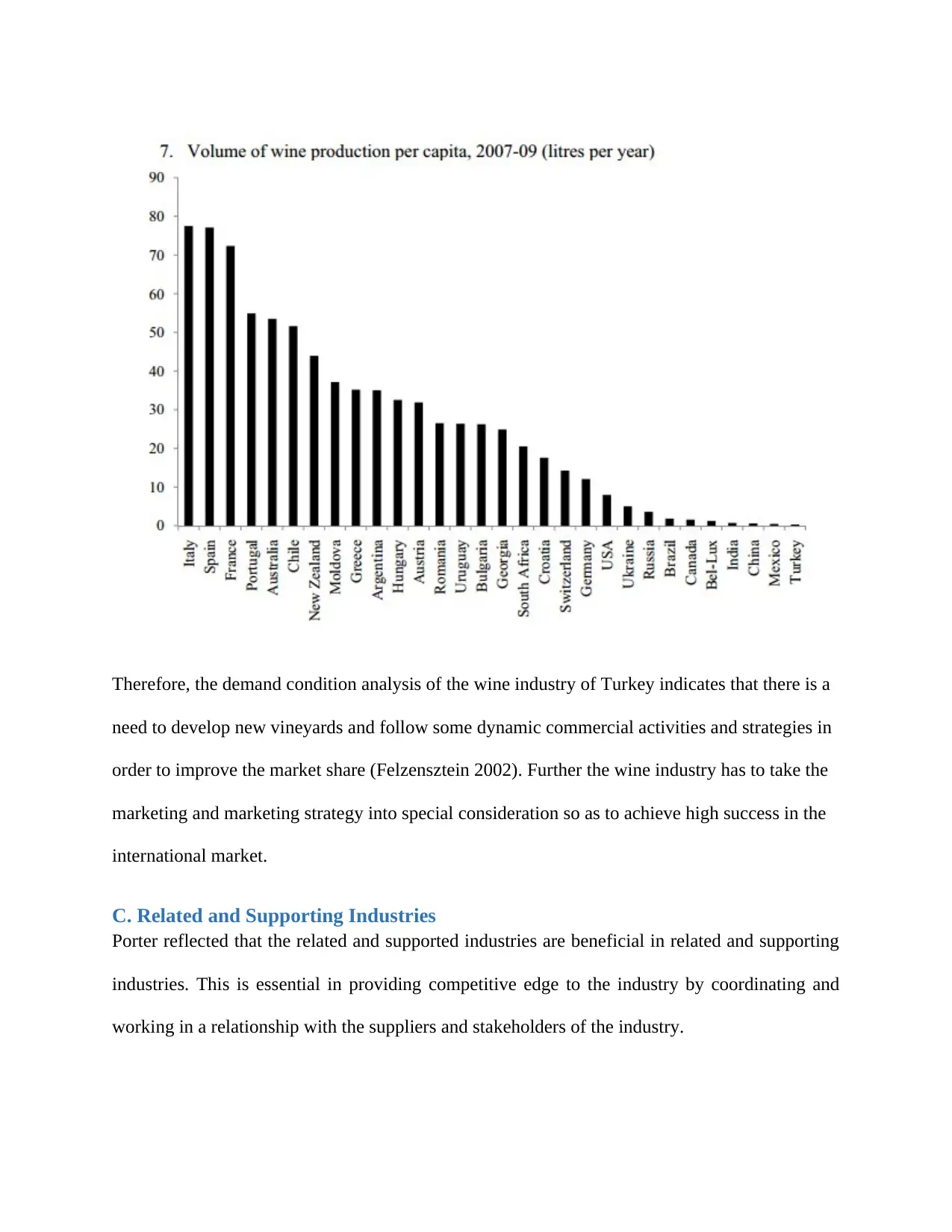
Therefore, the demand condition analysis of the wine industry of Turkey indicates that there is a
need to develop new vineyards and follow some dynamic commercial activities and strategies in
order to improve the market share (Felzensztein 2002). Further the wine industry has to take the
marketing and marketing strategy into special consideration so as to achieve high success in the
international market.
C. Related and Supporting Industries
Porter reflected that the related and supported industries are beneficial in related and supporting
industries. This is essential in providing competitive edge to the industry by coordinating and
working in a relationship with the suppliers and stakeholders of the industry.
need to develop new vineyards and follow some dynamic commercial activities and strategies in
order to improve the market share (Felzensztein 2002). Further the wine industry has to take the
marketing and marketing strategy into special consideration so as to achieve high success in the
international market.
C. Related and Supporting Industries
Porter reflected that the related and supported industries are beneficial in related and supporting
industries. This is essential in providing competitive edge to the industry by coordinating and
working in a relationship with the suppliers and stakeholders of the industry.
Paraphrase This Document
Need a fresh take? Get an instant paraphrase of this document with our AI Paraphraser

With the huge production of grapes in the country, a large section is supported by the table
grapes. Therefore, the wine industry is seen to profit due to the increased demands of the table
grapes. This has a major support for the wine making industry. Further a continuous and integral
collaboration among the wine industry and with R&D department has helped in enhancing the
taste flavour of the wines and related drinks.
One of the most contributing industry to the wine industry of Turkey is the hotels, restaurants
and catering (HORECA) industry. It is one of the most critical sector for development and
distribution of the wine industry in Turkey as the Turkish people enjoy outside entertainment as
compared to their home. This sector alone caters for around 20 to 25 million of tourists on the
annual basis (Gumus, S.G. and Gumus, A.H., 2008). Additionally the sectors like chain stores,
departmental store along with packaging material and their suppliers contribute to the wine
sector of the company. However, with the change in taste trends among the people and tourists
have led to increased demand of HORECA industry and enterprise towards the wine industry.
A vast majority of restaurant and hotel chains buy their wines from the specialist distributors but
the small sized places in the same enterprise buy from tradition retail channels and wholesalers
or from supermarkets. Due to upcoming of more hotels and restaurants, the demands for different
wines is seen to increase. This is seen to raise difficulties among the wine marketers and is
perceived to be one of the greatest marketing problem. Additionally the increased demands from
the chain stores also added to the problem. The country is also seen to face issues related to the
supplying of unregistered products by some of the firms in the market place, leading to other
problems in the wine industry and its markets (Ay, H.M., 2008).
grapes. Therefore, the wine industry is seen to profit due to the increased demands of the table
grapes. This has a major support for the wine making industry. Further a continuous and integral
collaboration among the wine industry and with R&D department has helped in enhancing the
taste flavour of the wines and related drinks.
One of the most contributing industry to the wine industry of Turkey is the hotels, restaurants
and catering (HORECA) industry. It is one of the most critical sector for development and
distribution of the wine industry in Turkey as the Turkish people enjoy outside entertainment as
compared to their home. This sector alone caters for around 20 to 25 million of tourists on the
annual basis (Gumus, S.G. and Gumus, A.H., 2008). Additionally the sectors like chain stores,
departmental store along with packaging material and their suppliers contribute to the wine
sector of the company. However, with the change in taste trends among the people and tourists
have led to increased demand of HORECA industry and enterprise towards the wine industry.
A vast majority of restaurant and hotel chains buy their wines from the specialist distributors but
the small sized places in the same enterprise buy from tradition retail channels and wholesalers
or from supermarkets. Due to upcoming of more hotels and restaurants, the demands for different
wines is seen to increase. This is seen to raise difficulties among the wine marketers and is
perceived to be one of the greatest marketing problem. Additionally the increased demands from
the chain stores also added to the problem. The country is also seen to face issues related to the
supplying of unregistered products by some of the firms in the market place, leading to other
problems in the wine industry and its markets (Ay, H.M., 2008).
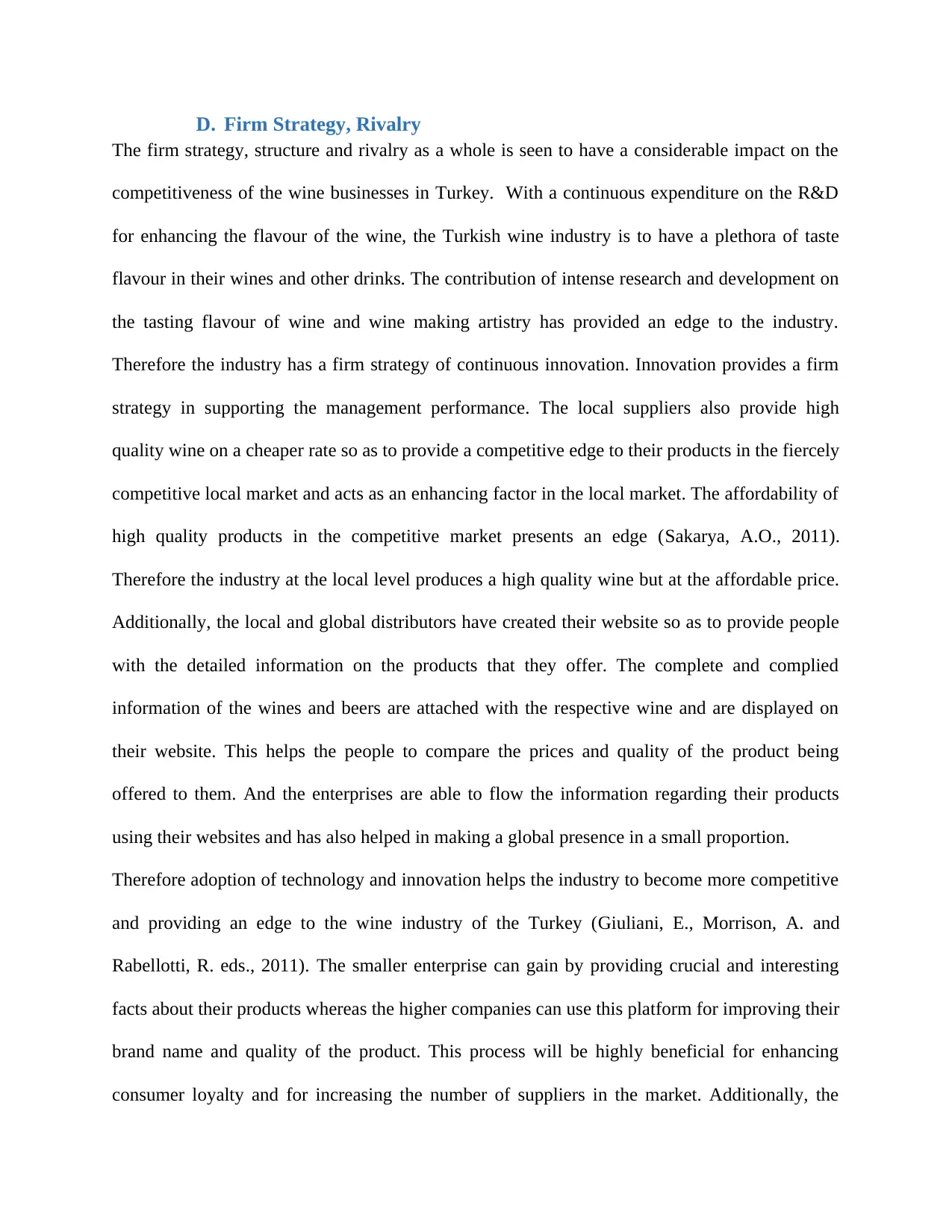
D. Firm Strategy, Rivalry
The firm strategy, structure and rivalry as a whole is seen to have a considerable impact on the
competitiveness of the wine businesses in Turkey. With a continuous expenditure on the R&D
for enhancing the flavour of the wine, the Turkish wine industry is to have a plethora of taste
flavour in their wines and other drinks. The contribution of intense research and development on
the tasting flavour of wine and wine making artistry has provided an edge to the industry.
Therefore the industry has a firm strategy of continuous innovation. Innovation provides a firm
strategy in supporting the management performance. The local suppliers also provide high
quality wine on a cheaper rate so as to provide a competitive edge to their products in the fiercely
competitive local market and acts as an enhancing factor in the local market. The affordability of
high quality products in the competitive market presents an edge (Sakarya, A.O., 2011).
Therefore the industry at the local level produces a high quality wine but at the affordable price.
Additionally, the local and global distributors have created their website so as to provide people
with the detailed information on the products that they offer. The complete and complied
information of the wines and beers are attached with the respective wine and are displayed on
their website. This helps the people to compare the prices and quality of the product being
offered to them. And the enterprises are able to flow the information regarding their products
using their websites and has also helped in making a global presence in a small proportion.
Therefore adoption of technology and innovation helps the industry to become more competitive
and providing an edge to the wine industry of the Turkey (Giuliani, E., Morrison, A. and
Rabellotti, R. eds., 2011). The smaller enterprise can gain by providing crucial and interesting
facts about their products whereas the higher companies can use this platform for improving their
brand name and quality of the product. This process will be highly beneficial for enhancing
consumer loyalty and for increasing the number of suppliers in the market. Additionally, the
The firm strategy, structure and rivalry as a whole is seen to have a considerable impact on the
competitiveness of the wine businesses in Turkey. With a continuous expenditure on the R&D
for enhancing the flavour of the wine, the Turkish wine industry is to have a plethora of taste
flavour in their wines and other drinks. The contribution of intense research and development on
the tasting flavour of wine and wine making artistry has provided an edge to the industry.
Therefore the industry has a firm strategy of continuous innovation. Innovation provides a firm
strategy in supporting the management performance. The local suppliers also provide high
quality wine on a cheaper rate so as to provide a competitive edge to their products in the fiercely
competitive local market and acts as an enhancing factor in the local market. The affordability of
high quality products in the competitive market presents an edge (Sakarya, A.O., 2011).
Therefore the industry at the local level produces a high quality wine but at the affordable price.
Additionally, the local and global distributors have created their website so as to provide people
with the detailed information on the products that they offer. The complete and complied
information of the wines and beers are attached with the respective wine and are displayed on
their website. This helps the people to compare the prices and quality of the product being
offered to them. And the enterprises are able to flow the information regarding their products
using their websites and has also helped in making a global presence in a small proportion.
Therefore adoption of technology and innovation helps the industry to become more competitive
and providing an edge to the wine industry of the Turkey (Giuliani, E., Morrison, A. and
Rabellotti, R. eds., 2011). The smaller enterprise can gain by providing crucial and interesting
facts about their products whereas the higher companies can use this platform for improving their
brand name and quality of the product. This process will be highly beneficial for enhancing
consumer loyalty and for increasing the number of suppliers in the market. Additionally, the
⊘ This is a preview!⊘
Do you want full access?
Subscribe today to unlock all pages.

Trusted by 1+ million students worldwide
1 out of 25
Your All-in-One AI-Powered Toolkit for Academic Success.
+13062052269
info@desklib.com
Available 24*7 on WhatsApp / Email
![[object Object]](/_next/static/media/star-bottom.7253800d.svg)
Unlock your academic potential
Copyright © 2020–2025 A2Z Services. All Rights Reserved. Developed and managed by ZUCOL.

